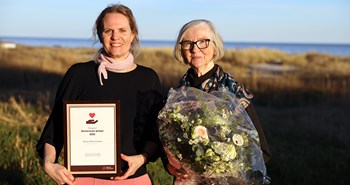Sammenhængen mener forskerne skal findes i et øget fokus på forebyggelse af hjertekarsygdomme, der i høj grad opstår på grund af en usund livsstil.
”Det er rigtig gode nyheder,” siger direktør i Alzheimerforeningen, Nis Peter Nissen, der mener at de nye forskningsresultater giver grund til optimisme:
”For det første tyder de nye tal på at vi rent faktisk kan nedsætte risikoen for at få en demenssygdom – og endnu bedre: der er flere og flere forskningsresultater, der viser, at en målrettet indsats også virker for personer med demens i en tidlig eller middelsvær fase.
For det andet vil antallet af demente ikke stige helt så dramatisk som vi tidligere har troet. Og det er positivt for det betyder, at vi får bedre råd til at udrede, behandle og pleje de demenspatienter, der rent faktisk kommer fremover.”
Nis Peter Nissen understreger dog, at antallet af demente – på trods af færre nye tilfælde end tidligere antaget – fortsat vil stige sammenlignet med i dag, alene fordi der i de kommende år kommer mange flere ældre, i takt med, at de store krigsgenerationer (der er født i midten af 40’erne) bliver ældre. Nis Peter Nissen peger også på, at vi heller ikke ved, hvad effekten af andre livsstilssygdomme, som for eksempel det stigende antal mennesker med diabetes, vil betyde for demensudviklingen.
For kommentarer og uddybende spørgsmål, kontakt Alzheimerforeningens direktør, Nis Peter Nissen på telefon: 2120 1224.
Se resuméer af undersøgelserne nedenfor:
Temporal trends in Dementia Incidence in the Framingham Study Author Block
Claudia L. Satizabal1, Alexa Beiser3, Geneviève Chêne6, Vincent A. Chouraki1, Jayandra J. Himali1, Sarah R. Preis2, Sanford Auerbach1, Rhoda Au4, Philip A. Wolf1, Carole Dufouil5, Sudha Seshadri1, 1Boston University School of Medicine, Framingham Heart Study , Boston, Massachusetts, United States, 2Boston University School of Public Health, Framingham Heart Study , Boston, Massachusetts, United States, 3Boston University Schools of Medicine and Public Health, Framingham Heart Study , Boston, Massachusetts, United States, 4Framingham Heart Study/Boston University , Framingham, Massachusetts, United States, 5INSERM U708 & CIC-EC7, University of Bordeaux, Isped (Bordeaux School of Public Health) , Bordeaux, France, 6Inserm U897 and CIC-EC7; University of Bordeaux, Isped (Bordeaux School of Public Health), Bordeaux, France
Background: Recent studies from Europe suggest age-specific dementia incidence is declining, although the overall burden of dementia grows as life-expectancy increases. This has been attributed to an improved control of vascular risk factors. However, a large US study observed no decline in dementia incidence despite a lower risk of cognitive impairment. We studied temporal trends in dementia incidence over three decades among Framingham Study participants. Methods: Framingham participants periodically undergo comprehensive assessments for risk factors once every 2-4 years, and remain under intensive surveillance for incident disease including dementia and stroke. We defined four epochs across the past three decades, each anchored at a baseline examination, and studied 5-year dementia incidence among all dementia-free participants aged =60 years who attended that examination. We examined the baseline prevalence of vascular risk factors and calculated dementia incidence in each epoch. Age- and sex-adjusted Cox proportional-hazard models were used to compare the incidence across epochs. In secondary analyses, we examined both whether these trends differed within age, gender and education categories, and the impact of additional adjustment for interim stroke. Results: Compared to the first epoch, there were 17%, 32% and 42% reductions in dementia incidence in the second, third and fourth epochs respectively. Additional adjustment for stroke did not modify our results. This reduction was strongest in younger participants (60-69 years) and in the last epoch for all age categories. Reductions in dementia incidence were similar for women and men in the last epoch. Interestingly, participants with at least high school education had a consistent reduction in dementia incidence across all time-periods, while those less educated did not. We observed significant improvements in educational status, use of antihypertensive and statin medication, blood pressure and HDL levels and in prevalence of smoking, heart disease and stroke, whereas prevalence of obesity and diabetes increased. Conclusions: In the last three decades, age-specific incidence rates of dementia have declined in the Framingham cohort. These reductions might be partly explained by beneficial trends in educational attainment, vascular risk factors (acting only partly through clinical stroke) and lifestyle, leading to cautious optimism that some dementia may be preventable.
Table
Is the Risk of Alzheimer's Disease Declining?: A Review of Evidence From Around the World Author Block
Kenneth M Langa1, 1University of Michigan and Ann Arbor VA , Ann Arbor, Michigan, United States
Background: The number of older adults with dementia will increase around the world in the decades ahead as populations age. Current estimates suggest that about 4.2 million adults in the United States have dementia and the attributable economic cost of their care is about US$200 billion per year. Worldwide dementia prevalence is estimated at 35.6 million people with a total cost of US$604 billion per year, and it is expected that worldwide prevalence will nearly triple to 115 million by 2050. However, a number of recent population-based studies from countries around the world suggest that the age-specific risk of dementia may be declining, which could help moderate the expected increase in dementia cases that will accompany the growing number of older adults.Methods: This presentation will review the current published evidence on the prevalence and economic costs of dementia in countries around the world, and whether the age-specific risk of Alzheimer's disease and dementia has declined over the past twenty years. Results: At least 5 recent population-based studies of dementia incidence or prevalence have shown a declining age-specific risk in the United States, Rotterdam, Stockholm, and England. A number of factors, especially rising levels of education and more aggressive treatment of key cardiovascular risk factors such as hypertension and hypercholesterolemia, may be leading to improving “brain health” and declining age-specific risk of AD and dementia in countries around the world.Conclusions: Whether this optimistic trend of declining dementia risk will continue in the face of rising levels of obesity and diabetes, and whether this trend is also occurring in low- and middle-income countries are key unanswered questions which will have enormous implications for the extent of the future world-wide impact of AD and dementia on patients, families, and societies in the decades ahead.
Short-term Trends in German Dementia Prevalence, Incidence, and Mortality Author Block
Gabriele Doblhammer1, Anne Fink2, Stephanie Zylla4, Thomas Fritze1, Frans Willekens3, 1German Center for Neurodegenerative Diseases (DZNE) , Rostock, Germany, 2German Center for Neurodegenerative Diseases , Rostock, Germany, 3Max Planck Institute for Demographic Research , Rostock, Germany, 4University of Rostock , Rostock, Germany
Background: Recent studies have been cautiously optimistic about declining trends in dementia prevalence and incidence. This study explored short-terms trends in dementia prevalence, incidence and mortality in Germany using health claims data. We hypothesized that the period prevalence of dementia has been declining while the incidence of dementia has been shifting to higher ages. Methods: We used claims data of the largest public health insurance company in Germany. The data contained complete inpatient and outpatient diagnoses according to ICD-10. For the analysis of prevalence we used 6.5 million persons and 600,000 dementia cases for each of the years 2007, 2008, and 2009 applying negative binomial regression models. For the analysis of incidence and mortality two independent age-stratified samples of all insured persons aged 65 were taken. The first sample consisted of 139,617 persons in 2004 with a follow-up until 2007; the second sample of 134,653 persons in 2007 with a follow-up until 2010. Dementia was defined by the ICD numbers G30, G31.0, G31.82, G23.1, F00, F01, F02, F03, and F05.1. We estimated Cox-proportional hazard models to compare the incidence of dementia and the mortality of dementia patients between the two samples. Results: Over the period of 2007 to 2009, the prevalence of dementia decreased significantly among German women at ages 74 to 85. Compared to 2009, the prevalence was 3.6 per cent higher in 2007 (p=0.001) and 1.8 per cent higher in 2008 (p=0.019). A similar, albeit statistically not significant trend, was found for males of the same age. Also incidence decreased in the more recent sample: for females the relative risk (RR) of dementia in the 2004 sample was 1.25 (p=0.000) as compared to the most recent 2007 sample. For males it was 1.23 (p=0.000). Mortality of dementia patients increased significantly among women (RR 2004 as compared to 2007: 0.90; p=0.000), while it remained stable among men (RR 2004 as compared to 2007: 0.99; p=0.746). Conclusions: This is the first study that explored trends in dementia in Germany. The decline observed in this study, both in dementia prevalence and incidence, is of major consequences for the number of future dementia cases.



















